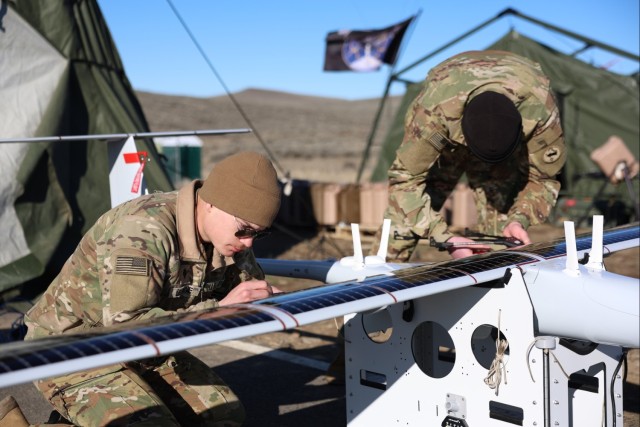YAKIMA TRAINING CENTER, Wash. — Within the foothills of the Cascade Mountain range, the 1st Multi-Domain Effects Battalion from the 1st Multi-Domain Task Force conducted the Army’s first battalion-level All-Domain Home Station Training exercise, Static Focus 3. Held from March 3-14, 2025, the exercise took place at the Yakima Training Center in conjunction with Project Convergence Capstone 5.
Static Focus 3 enabled live training of the MDEB’s family of systems used to conduct reconnaissance, surveillance and target acquisition and non-kinetic effects execution. The 1st MDEB, activated concurrently with the 1st MDTF in 2020, integrates the task force’s information, intelligence, cyber, electromagnetic warfare and space capabilities.
A highlight of the training was the network extension integration and deep sensing capability of high-altitude balloons and the experimentation with ultra long-endurance, solar powered unmanned aircraft system.
“This is our first real exercise integrating government owned and operated ultra long-endurance UAS specifically designed for long-range deep sensing,” said Lt. Col. Joseph Mroszczyk, commander of the 1st MDEB.
Prior to the exercise, the unit spent two years testing and training with the platform alongside the long-endurance UAS system’s contractor, Kraus Hamdani Aerospace. It wasn’t until this event that the Soldiers were able to independently operate the system.
"We've got trained pilots and mechanics gaining valuable experience on the platform now," Lt. Col. Mroszczyk added. "They're logging hours and providing crucial sensor data, enabling us to serve as the task force's eyes and ears, and as key contributing Army sensor to the Joint Force."
During Static Focus 3, the 1st MDEB logged over a hundred UAS flight hours in various configurations.
"From a maintenance perspective, I was astonished by how little time and resources the platform demanded," said Sgt. Jake Meyer from the UAS Platoon from the Extended Range and Sensing Effects Company with the 1st MDEB. "Compared to traditional platforms, which require several months to get familiarized with, we were up and running in just two days.”
Max endurance testing was included in the experimentation of the platform, to include multi-ship flights.
"Multi-ship flight operations are the most complex missions, but the autonomous capability allows me, as an operator, to focus on the mission instead of my continuous direct management of each aircraft," said Staff Sgt. Jacob Wilbert from the UAS Platoon, ERSE Company, 1st MDEB.
Complementary to the long-range deep sensing UAS, the unit also experimented with HABs from three vendors, sponsored by the Army Intelligence, Surveillance and Reconnaissance Task Force for inclusion in the event and in conjunction with PC-C5.
"For me, the highlight of the event was witnessing the successive launches from all three HAB vendors and creating a constellation. Being part of this was exhilarating, because each vendor offered their own unique features and capabilities," said Sgt. Antonio Morales from the High-Altitude Balloon Platoon, ERSE Company, 1st MDEB.
Previously, the unit had to travel to Fort Huachuca, Arizona, to access the same level of training. Static Focus 3 not only reduced the cost of traveling to Arizona to train, but also served as a valuable technical rehearsal for future employment.
“The progress that we’ve made over this last week greatly enhanced our capability as a task force," said Mroszczyk.
As a theater-level unit and joint force enabler, assigned to the Indo-Pacific, the 1st MDTF plays a vital role in synchronizing long-range precision fires layered with long-range precision effects to create multiple dilemmas and neutralize adversary anti-access and area denial networks. The MDTF’s proven innovation, agility, and lethality have led the Army to direct five full MDTFs in strategically significant locations worldwide.
PC-C5 is an Army hosted experiment that provides Joint and Multinational participants various locations that supports individual modernization efforts while solving problems through applications with Combined, Joint All Domain Operations. PC-C5 ensures that the Army, can rapidly and continuously converge effects across all domains — air, land, sea, space and cyber, to increase operational tempo and generate decision advantage over our adversaries. These structured series of experiments demonstrate transformation and modernization efforts, expand war-winning capabilities and deliver the Army of 2030 while designing the Army of 2040.












Social Sharing